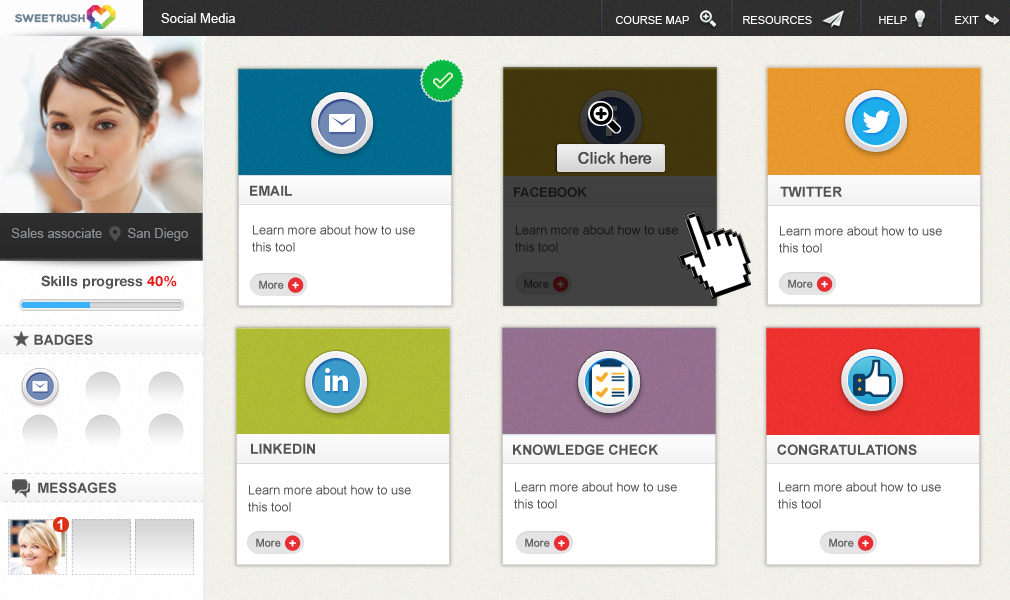Drag-and-drop. Multiple-choice. Matching. These tried-and-true activities have become the staples of e-learning. To me, they’re kind of like the coat and shoes you use to walk the dog: They have their place, serve a purpose, and get the job done, but they shouldn’t be your first choice when you need to really dress to impress!
Now, we all know that engaging the learner is essential to the success of every e-learning program. Including interactive elements increases the effectiveness of the training, capitalizes on the latent strengths of digital media, and increases the ultimate ROI of the training investment. Basic activities such as a simple drag-and-drop do fulfill our objective of having learners stop, think about what they’ve learned, and demonstrate their proficiency with the material. Box checked.
But let’s say your objectives are more complex: Rather than just demonstrating knowledge, you need your learners to acquire new skills, or you want to teach them to think critically. To get learners to engage at these higher cognitive levels, you need to carefully construct activities that challenge them in new ways.
Another reason to move beyond drag-and-drop is your audience. In today’s corporate world, we are seeing an influx of new learners (Millennials) who are knowledgeable consumers and users of digital media and games. Growing up with computers and video games means these learners have higher expectations about interactivity out of the gate, which means keeping them engaged requires more-complex activities. (Read more about this in Tips for Training Millennials.)
So now that you know some of the reasons your dog-walking coat might not work so well for your dinner business meeting, how do you show up looking sharp and turning heads? Let me introduce you to a few of my favorite things:
Discovery learning
Discovery learning can take many forms, but it is essentially structuring information in an e-learning course so that it is found rather than presented. Participants learn through active participation, rather than by passively receiving information in a presentation format. They learn from both their successes and their mistakes, which keeps them engaged. An example of this is teaching a new software program: Rather than take learners through each type of task step by step (which can be tedious), we give them a task to complete, and then provide tips and feedback as they try to complete it. This is done in a simulated (and safe) environment, of course!
Goal-based scenarios
These types of scenarios remind us of choose-your-own-adventure stories. We set up a certain situation, and provide the learner with a goal to complete. As they make decisions to try to achieve the goal, different consequences ensue. The decision points impact the evolution of the story. Learners may need to evaluate documents or interview other characters to find the information they need to complete the scenario successfully. Coaches may be used to provide tips or highlight key concepts along the way.
Avatars
Studies show that the addition of a virtual character (an avatar) to e-learning courses impacts knowledge retention, course completion, and recall of content. By interacting with a character in a virtual world, learners become more engaged in the subject matter, helping them learn more effectively. Virtual characters increase learner potential through prompts, summaries, flash cards, practice tests, and interactive scenarios, while delivering training in a more interactive and entertaining format.
The list doesn’t end there: We use social simulations, frame games, immersive learning simulations, and many more techniques to maximize learner engagement, knowledge retention, and application of learning on the job. With so many rich, engaging e-learning activities to choose from, one of the best parts of my job is opening our closet and finding the perfect fit!
Tell me… What are a few of your favorite things?





Hello! Thank you for your article! I currently design training for state government and law enforcement members. Although I follow the best practices of e-learning, I have found that these don’t always apply to law enforcement. They typically don’t like the use of avatars in their training, and prefer a straightforward no-nonsense approach to content; however, there is still a “learning hang-up” when online training is made available. This makes me think there is a piece missing! Do you have any suggestions for engaging such professionals in the law enforcement field?